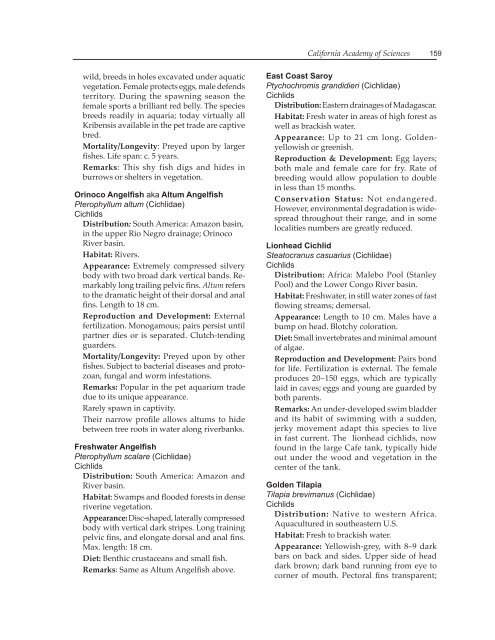THE STEINHART AQUARIUM - Gulf of Guinea Science ...
THE STEINHART AQUARIUM - Gulf of Guinea Science ...
THE STEINHART AQUARIUM - Gulf of Guinea Science ...
You also want an ePaper? Increase the reach of your titles
YUMPU automatically turns print PDFs into web optimized ePapers that Google loves.
wild, breeds in holes excavated under aquatic<br />
vegetation. Female protects eggs, male defends<br />
territory. During the spawning season the<br />
female sports a brilliant red belly. The species<br />
breeds readily in aquaria; today virtually all<br />
Kribensis available in the pet trade are captive<br />
bred.<br />
Mortality/Longevity: Preyed upon by larger<br />
fishes. Life span: c. 5 years.<br />
Remarks: This shy fish digs and hides in<br />
burrows or shelters in vegetation.<br />
Orinoco Angelfish aka Altum Angelfish<br />
Pterophyllum altum (Cichlidae)<br />
Cichlids<br />
Distribution: South America: Amazon basin,<br />
in the upper Rio Negro drainage; Orinoco<br />
River basin.<br />
Habitat: Rivers.<br />
Appearance: Extremely compressed silvery<br />
body with two broad dark vertical bands. Remarkably<br />
long trailing pelvic fins. Altum refers<br />
to the dramatic height <strong>of</strong> their dorsal and anal<br />
fins. Length to 18 cm.<br />
Reproduction and Development: External<br />
fertilization. Monogamous; pairs persist until<br />
partner dies or is separated. Clutch-tending<br />
guarders.<br />
Mortality/Longevity: Preyed upon by other<br />
fishes. Subject to bacterial diseases and protozoan,<br />
fungal and worm infestations.<br />
Remarks: Popular in the pet aquarium trade<br />
due to its unique appearance.<br />
Rarely spawn in captivity.<br />
Their narrow pr<strong>of</strong>ile allows altums to hide<br />
between tree roots in water along riverbanks.<br />
Freshwater Angelfish<br />
Pterophyllum scalare (Cichlidae)<br />
Cichlids<br />
Distribution: South America: Amazon and<br />
River basin.<br />
Habitat: Swamps and flooded forests in dense<br />
riverine vegetation.<br />
Appearance: Disc-shaped, laterally compressed<br />
body with vertical dark stripes. Long training<br />
pelvic fins, and elongate dorsal and anal fins.<br />
Max. length: 18 cm.<br />
Diet: Benthic crustaceans and small fish.<br />
Remarks: Same as Altum Angelfish above.<br />
California Academy <strong>of</strong> <strong>Science</strong>s<br />
159<br />
East Coast Saroy<br />
Ptychochromis grandidieri (Cichlidae)<br />
Cichlids<br />
Distribution: Eastern drainages <strong>of</strong> Madagascar.<br />
Habitat: Fresh water in areas <strong>of</strong> high forest as<br />
well as brackish water.<br />
Appearance: Up to 21 cm long. Goldenyellowish<br />
or greenish.<br />
Reproduction & Development: Egg layers;<br />
both male and female care for fry. Rate <strong>of</strong><br />
breeding would allow population to double<br />
in less than 15 months.<br />
Conservation Status: Not endangered.<br />
However, environmental degradation is widespread<br />
throughout their range, and in some<br />
localities numbers are greatly reduced.<br />
Lionhead Cichlid<br />
Steatocranus casuarius (Cichlidae)<br />
Cichlids<br />
Distribution: Africa: Malebo Pool (Stanley<br />
Pool) and the Lower Congo River basin.<br />
Habitat: Freshwater, in still water zones <strong>of</strong> fast<br />
flowing streams; demersal.<br />
Appearance: Length to 10 cm. Males have a<br />
bump on head. Blotchy coloration.<br />
Diet: Small invertebrates and minimal amount<br />
<strong>of</strong> algae.<br />
Reproduction and Development: Pairs bond<br />
for life. Fertilization is external. The female<br />
produces 20–150 eggs, which are typically<br />
laid in caves; eggs and young are guarded by<br />
both parents.<br />
Remarks: An under-developed swim bladder<br />
and its habit <strong>of</strong> swimming with a sudden,<br />
jerky movement adapt this species to live<br />
in fast current. The lionhead cichlids, now<br />
found in the large Cafe tank, typically hide<br />
out under the wood and vegetation in the<br />
center <strong>of</strong> the tank.<br />
Golden Tilapia<br />
Tilapia brevimanus (Cichlidae)<br />
Cichlids<br />
Distribution: Native to western Africa.<br />
Aquacultured in southeastern U.S.<br />
Habitat: Fresh to brackish water.<br />
Appearance: Yellowish-grey, with 8–9 dark<br />
bars on back and sides. Upper side <strong>of</strong> head<br />
dark brown; dark band running from eye to<br />
corner <strong>of</strong> mouth. Pectoral fins transparent;


